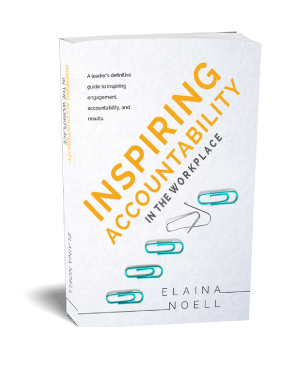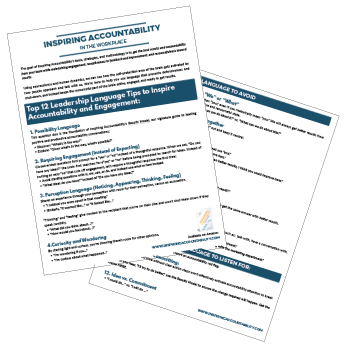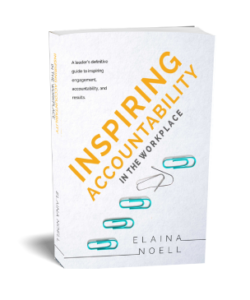What Does Accountability Mean (in the Workplace)?

What Does Accountability Mean in the Workplace?
Prefer to listen to this blog? You can here!
There are many definitions of how accountability is defined in the workplace. Arguably, many are technically correct, but some are less useful than others when it comes to improving results-the top reason accountability gets requested (or demanded) in the first place.
Let’s start with the definition of accountability, as defined by Google:
“1. (of a person, organization, or institution) required or expected to justify actions or decisions. Synonyms: responsible, liable, answerable; to blame.”
This traditional accountability is the kind that triggers our creature brain into fight, freeze, or flight mode. This tried and true reaction has been in place since the beginning of time, and it leads to disengagement, poorer receptivity to feedback, and decreased resourceful toward solutions.
Once this safety response is activated, you can’t fight it; you can only prevent it.
This is what inspiring accountability aims to do: provide a better solution than the traditional and triggering accountability approach, and instead get results in a way that maximizes engagement, receptiveness to feedback, and resourcefulness toward results. We do this by working with what makes us human instead of trying to fight it.
“Until taking accountability becomes a productive choice that results in a positive experience, there isn’t an incentive for the competence-protecting creature brain to eagerly volunteer.”
We can’t expect it to be appealing to accept blame if it means proclaiming incompetence. Until taking accountability becomes a productive choice that results in a positive experience, there isn’t an incentive for the safety-seeking, competence-protecting creature brain to eagerly volunteer.
If you want to inspire accountability, you must work with what makes us human to get better results. Let’s look at how we can do that by exploring a breakdown of the most common synonyms of accountability in the workplace, and then we’ll look at better solutions to get improve employee performance.
Inspiring Accountability is not:
-
- Taking responsibility or proclaiming fault to end a blame game
- Compliance
- Ownership
In Part 1 of this blog series, we’ll look at the first common definition of traditional accountability and discover a more useful approach.
Taking Responsibility (to End a Blame Game)
While taking responsibility for one’s actions is associated with maturity and respect, the majority of workplace cultures don’t make this a “safe” choice for an employee’s self-protective creature brain.
When taking responsibility is required to end a search for who’s at fault, the creature brain has already triggered it’s safety-system response. This classic fight-freeze-flight response actually minimizes use of the rational brain to prioritize aspects that physically support fighting or fleeing (like muscles-not usually important in solving a missed deadline).
This means the rational part of the brain, the one that can best help create needed solutions in times of missed results, is temporarily offline. Engagement, receptiveness, and resourcefulness are essentially out of reach, making the sought after admission of fault a destructive deed instead of a generative choice.
The need for others to take accountability or responsibility comes up only when leadership is focusing on problems and not solutions.
So how does one approach taking responsibility more productively? By facilitating employees to be responsible for the solution instead of the problem.
“Employees don’t need to endure guilt, blame, or shame to motivate improvement. In fact, these become triggering impediments to better solutions and future results.”
Inspiring Accountability Solution:
If you could get a better result without needing to know who’s to blame or what happened, would that be okay? Most managers’ creature brains don’t see it as safe to let an employee “off the hook” so easily. How will they learn if they don’t feel the depth of the destruction of their actions, usually communicated through disappointment, anger, or frustration?
Fear does indeed motivate. But that motivation comes with destructive consequences.
Employees don’t need to endure guilt, blame, or shame to motivate improvement. As mentioned briefly above, guilt and its related companions actually become triggering impediments to better solutions and future results.
Focusing on the past and what went wrong may seem like a necessary step to understand the problem and prevent it in the future. But similar to Albert Einstein’s suggestion that “You can’t solve a problem with the same thinking that created the problem,” teams and leaders that focus on the problem are stuck in the same thinking that created that problem. And, to cite someone behind me at a rare appearance I made at a sports game, that’s going to take you to “Nowheresville, USA.”
Do you want your employees’ attention and energy stuck in the unchangeable past, exploring what didn’t work, or engaged, exploring what can be improved and done better? Which option better inspires engagement and is more likely to productively improve results? When employees don’t have to undergo blame and shame before contributing to solutions, dignity is kept intact, along with engagement, receptiveness, and resourcefulness.
With Inspiring Accountability, we similarly skip over spending time and energy on what not to do and move directly to the effort we can and will do to more productively get the result.
Taking Responsibility Conclusion
When your company’s mindset is Possibility Thinking, leaders and employees move quickly past “What’s in the way?” to “What’s possible?”
The Results Model is designed to guide productive accountability conversations that spend little time in “what’s in the way” and move swiftly to a question like, “given that we didn’t get the result the first time, what can we do to get it now or in the future?”
We can actually skip the blame game, keeping everyone at the table engaged and resourceful toward solutions, by not getting stuck in what got in the way and instead focusing on what’s possible.
Up next in Part Two of our What Does Accountability Mean series, let’s explore the relationship between Compliance and Accountability, and what to do to get employees bought-in and taking action. Read it now >
What do you think? Share your questions or experience in the comment section below!
Want new articles before they get published?
Subscribe!



